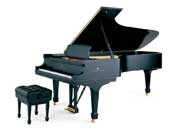by Daniel Hathaway
Cleveland, OH — July 29, 2011
Friday afternoon brought new faces and some fresh repertory to the penultimate session of the first round.
Ms. Marina Baranova (30, Ukraine/Germany) began the session with the first Beethoven “Waldstein” Sonata to appear in the playlist thus far, closely followed (with hardly any pauses) by Ligeti and Chopin. She took a businesslike approach to the first movement of the Beethoven. There were some tangles in scalar passages and an infelicitous plunge into the recapitulation. She paid more attention to voicing in the slow, second movement, with fine results. She did an intereresting thing at the beginning of the finale — starting it very slowly and softly as though the main theme were emerging from a haze, then making a huge crescendo into the restatement of the tune. Throughout, dynamics seemed to hover at both extremes with not much middle ground, but her soft playing was lovely. In her Ligeti, Fanfares (Etudes: Book 1, No. 4), she stylishly played sassy chords against a nonstop running line that alternated between hands. In her Chopin, the “Winter Wind” Etude, she demonstrated some sensitive phrasing, especially in the transitions.
Bach and Beethoven were the choices of Ms. Naomi Kudo (24, USA/Japan). The Prelude and Fugue in d from WTC II were lively, clean and free from pianisms. She played the fugue with thoughtful introspection, but kept her hands on the keyboard at the end, depriving the audience of an opportunity to applaud. Like several others, Ms. Kudo chose Beethoven’s D Major Sonata, but her version left us wondering if she thoroughly understood it. The first and last movements are really a conversation between contrasting thematic material. Here they became a monologue in the form of a run-on sentence with no pauses for breath. The second movement was played with extreme pathos and a sense of tragedy. She shied away from bringing out the important bass line in the third movement, and could have more effectively delineated the Q & A humor of the finale. But throughout her set Ms. Kudo played with a smile on her face and a demeanor that told us she really enjoyed being there.
Although all competitors have 30-35 minutes to spend in the first round, Ms. Fei Fei Dong (21, China) used only nineteen to make a big spash. After a witty and charming suite she created out of Scarlatti’s Sonatas in C, K. 196, f, K. 466 and D, K. 96 — a pair of hunting scenes separated by an adagio aria — she gave us Chopin’s “Waterfall” Etude (op. 10, no. 1) and Lowell Liebermann’s Gargoyles, op. 29 (1989). The Chopin is a rather vacuous showpiece; she tossed it off enthusiastically with a booming bass line and fluid right hand. Liebermann’s piece is a bizzare toccata — imagine all the grotesques at Notre-Dame in Paris climbing down from their niches and partying after hours. She played it powerfully but without sonic distortion and made a lovely moment out of the lonely aria that intervenes before the party resumes again. Ms. Dong brought formidable technique to her task this afternoon, but her choices of repertory didn’t give her much of an opportunity to demonstrate her ability to make interpretative decisions.
After intermission, Mr. Alexander Schimpf (29, Germany) brought “new” Beethoven and Chopin pieces to the stage. His healthy and well-conceived performance of Beethoven’s “Pastorale” Sonata (op. 28) was a delight to hear. He played with dark, expressive tone and fine pacing in the first movement, made excellent contrasts between left hand staccatos and lyrical right hand themes in the graceful second movement, and brought off the finale with consummate skill. He ended his set with Chopin’s “Revolutionary” Etude, a torrent of notes against a well-profiled theme. After a masterful display of left-hand clarity and agility, he ended the piece with a confident flourish. Watch him.
Perhaps the most memorable performance of the afternoon came from Mr. Mateusz Borowiak (23, UK/Poland), who turned in exemplary readinigs of Bach and Chopin. He began with Bach’s difficult Partita No. 2 in c and, unlike a lot of pianists, immediately showed us he held the composer’s intentions in high regard. He took all the repeats, adding subtle and stylistically credible ornamentation and sometimes bringing out surprising inner details the second time around. His fast tempos were spirited but not outlandish, his counterpuntal lines were clear and insightful, and he pointed up special harmonic moments subtly but effectively. His handling of the final Capriccio (no Gigue in this Partita) was brilliant and note perfect. Bach in the hands of pianists often makes me nervous, but this was a performance where you could trust the driver, sit back in your seat and enjoy. As an entremet, Mr. Borowiak served up Chopin’s “Chromatic” Etude (op. 10, no. 2), a beguilingly strange but tiny work documenting the composer as a harmonic maverick. The pianist’s admirable right hand work brought up that old image of a string of pearls. The final work, Chopin’s Scherzo No. 3 in c-sharp, op. 39, found Mr. Borowiak playing with a big, dark tone, creating weighty staccatos and breathtaking double octaves. His richly voiced chords (the tone was especially gorgeous in the softer repetition) inspired commentary by what sounded like clouds of babbling birds. Keep an eye on Mr. Borowiak too.
Friday evening’s session brings Round One to an end with contestants 23 through 26: Ms. Soo-Yeon Ham, Mr. Lu Shen, Mr. Daniele Rinaldo and Ms. Rina Sudo.




